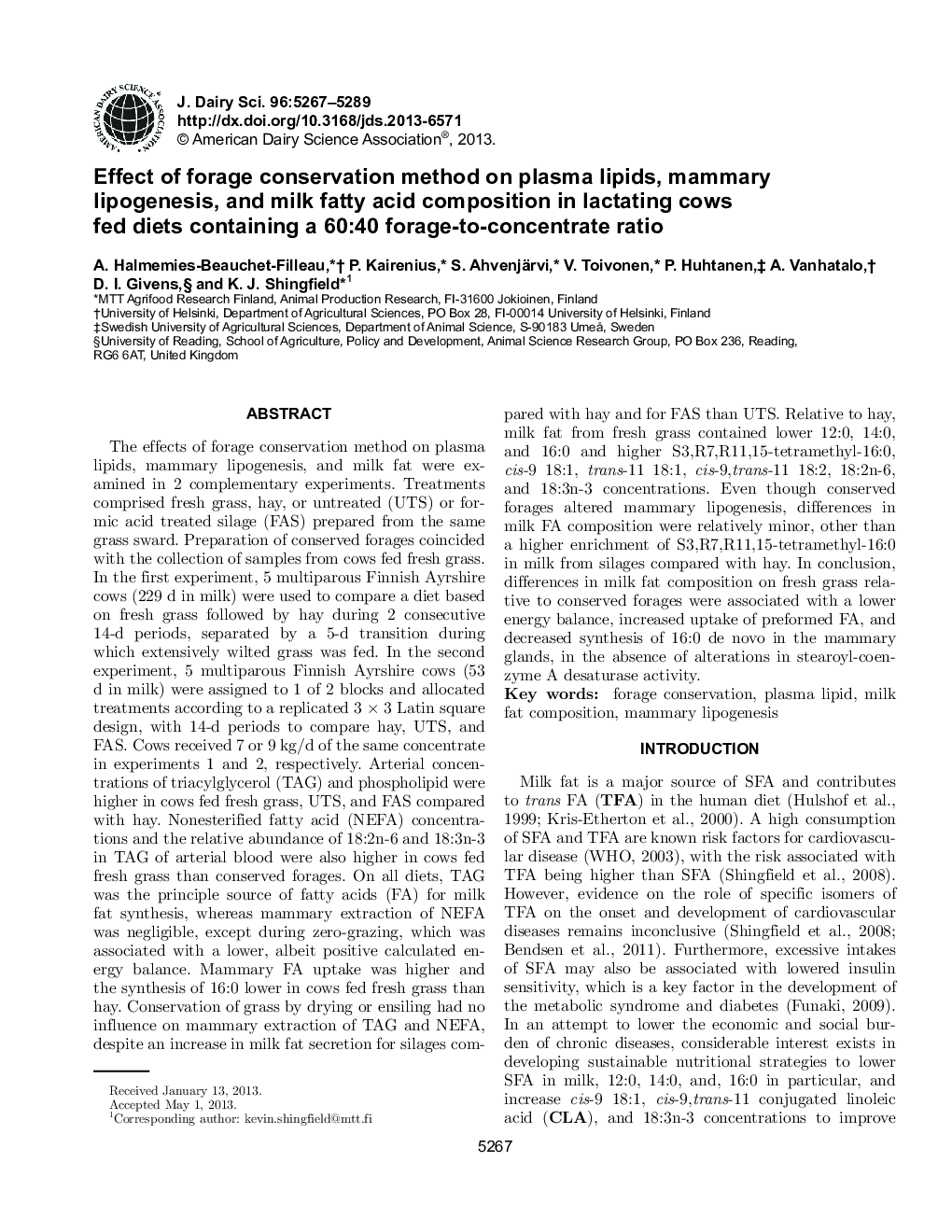| کد مقاله | کد نشریه | سال انتشار | مقاله انگلیسی | نسخه تمام متن |
|---|---|---|---|---|
| 2438905 | 1108051 | 2013 | 23 صفحه PDF | دانلود رایگان |
عنوان انگلیسی مقاله ISI
Effect of forage conservation method on plasma lipids, mammary lipogenesis, and milk fatty acid composition in lactating cows fed diets containing a 60:40 forage-to-concentrate ratio
دانلود مقاله + سفارش ترجمه
دانلود مقاله ISI انگلیسی
رایگان برای ایرانیان
موضوعات مرتبط
علوم زیستی و بیوفناوری
علوم کشاورزی و بیولوژیک
علوم دامی و جانورشناسی
پیش نمایش صفحه اول مقاله

چکیده انگلیسی
The effects of forage conservation method on plasma lipids, mammary lipogenesis, and milk fat were examined in 2 complementary experiments. Treatments comprised fresh grass, hay, or untreated (UTS) or formic acid treated silage (FAS) prepared from the same grass sward. Preparation of conserved forages coincided with the collection of samples from cows fed fresh grass. In the first experiment, 5 multiparous Finnish Ayrshire cows (229 d in milk) were used to compare a diet based on fresh grass followed by hay during 2 consecutive 14-d periods, separated by a 5-d transition during which extensively wilted grass was fed. In the second experiment, 5 multiparous Finnish Ayrshire cows (53 d in milk) were assigned to 1 of 2 blocks and allocated treatments according to a replicated 3Â ÃÂ 3 Latin square design, with 14-d periods to compare hay, UTS, and FAS. Cows received 7 or 9Â kg/d of the same concentrate in experiments 1 and 2, respectively. Arterial concentrations of triacylglycerol (TAG) and phospholipid were higher in cows fed fresh grass, UTS, and FAS compared with hay. Nonesterified fatty acid (NEFA) concentrations and the relative abundance of 18:2n-6 and 18:3n-3 in TAG of arterial blood were also higher in cows fed fresh grass than conserved forages. On all diets, TAG was the principle source of fatty acids (FA) for milk fat synthesis, whereas mammary extraction of NEFA was negligible, except during zero-grazing, which was associated with a lower, albeit positive calculated energy balance. Mammary FA uptake was higher and the synthesis of 16:0 lower in cows fed fresh grass than hay. Conservation of grass by drying or ensiling had no influence on mammary extraction of TAG and NEFA, despite an increase in milk fat secretion for silages compared with hay and for FAS than UTS. Relative to hay, milk fat from fresh grass contained lower 12:0, 14:0, and 16:0 and higher S3,R7,R11,15-tetramethyl-16:0, cis-9 18:1, trans-11 18:1, cis-9,trans-11 18:2, 18:2n-6, and 18:3n-3 concentrations. Even though conserved forages altered mammary lipogenesis, differences in milk FA composition were relatively minor, other than a higher enrichment of S3,R7,R11,15-tetramethyl-16:0 in milk from silages compared with hay. In conclusion, differences in milk fat composition on fresh grass relative to conserved forages were associated with a lower energy balance, increased uptake of preformed FA, and decreased synthesis of 16:0 de novo in the mammary glands, in the absence of alterations in stearoyl-coenzyme A desaturase activity.
ناشر
Database: Elsevier - ScienceDirect (ساینس دایرکت)
Journal: Journal of Dairy Science - Volume 96, Issue 8, August 2013, Pages 5267-5289
Journal: Journal of Dairy Science - Volume 96, Issue 8, August 2013, Pages 5267-5289
نویسندگان
A. Halmemies-Beauchet-Filleau, P. Kairenius, S. Ahvenjärvi, V. Toivonen, P. Huhtanen, A. Vanhatalo, D.I. Givens, K.J. Shingfield,